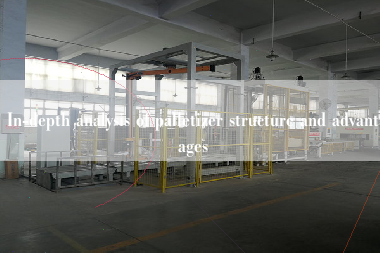A palletizer is an automated device used to stack items into a stable structure. It can be widely used in the fields of industry, logistics and warehousing. The structure and advantages of palletizing machines are important factors affecting their performance and efficiency. This article will deeply discuss the structure and advantages of palletizing machines from these two aspects.
1. Structure of the palletizing machine
The structure of the palletizer is divided into the following parts:

1. delivery system
The conveying system is the core part of the palletizer. It is responsible for transporting items from the production line or warehouse to the stacking area of the palletizer. The conveying system is usually composed of conveyor belts, rollers, chains, etc., which can be adjusted according to the shape and size of the item.
2. stacking system
The stacking system is another important part of a palletizer. It is responsible for stacking items into a stable structure. The stacking system usually consists of a robotic arm, a fixture, a suction cup, etc. These devices can be adjusted based on the shape and size of items to ensure items are stacked correctly.
3. control system
The control system is the brain of the palletizer. It is responsible for monitoring and controlling the operation of the conveying system and the stacking system. The control system is usually composed of PLC, touch screen, sensors, etc., and can be programmed according to the needs of the production line.
4. security system
The safety system is the protective device for the palletizer. It is responsible for monitoring and protecting the operation of the palletizer. The safety system is usually composed of a photoelectric switch, a safety door, an emergency stop button, etc., which can ensure the safe operation of the palletizer.
2. Advantages of palletizing machines
Palletizer has the following advantages:
1. improve production efficiency
The palletizer can automate the process of stacking items, thereby improving production efficiency. It can complete a large amount of stacking work in a short time, reducing labor costs and time costs.
2. improve product quality
The palletizer can be programmed to the needs of the production line to ensure that items are stacked correctly. It can avoid the impact of human factors on product quality and ensure the consistency and stability of product quality.
3. reduce labor intensity
The palletizer can automatically complete the process of stacking items, reducing the need for manual operations and reducing labor intensity. This is very beneficial for reducing workers ‘physical expenditure and promoting workers’ health.
4. improve security
The palletizer can protect the operation of the palletizer through a safety system to prevent accidents. It can improve the safety and stability of the workplace and protect the safety of workers ‘lives and property.
5. Increase the flexibility of the production line
The palletizer can be programmed according to the needs of the production line to flexibly adjust the stacking method and stacking height of items. It can adapt to different types and specifications of items, improving the flexibility and adaptability of the production line.
6. reduce production costs
The palletizer can automate the process of stacking items, reducing labor and time costs. It can improve production efficiency and product quality, reduce production costs, thereby improving the competitiveness of enterprises.
III. Conclusion
To sum up, a palletizer is an automated device that can stack items into a stable structure. Its structure and advantages are important factors affecting its performance and efficiency. By deeply understanding the structure and advantages of palletizing machines, we can better understand their working principles and application scenarios and provide better services for the company’s production and logistics.
